A History in Five Pages
Page 2
Sir Noel de Caron was ambassador to London for the 'States General of the United Provinces' (Holland and Flanders) in the early 1600s. He acquired land in Vauxhall on which he built a mansion in a large park which included what is now the Oval cricket ground, as well as a clear water spring known as Vauxhall Well. He built almshouses (opened in 1618) on the Wandsworth Road. They were acquired in 1853 by the Prices Candle Co on condition that they were replaced by the almshouses that can now be found on Fentiman Road. His name lives on in Carroun Road.
London's development gathered pace in the 1600s - as so did Vauxhall's, with a sort of intermission during the Civil War from around 1642 to 1651. London became a fortified city in this period and earthen-walled forts at Vauxhall and St George's Fields - and ramparts - divided the area in two. The fortifications were thrown up very quickly, so as to defend Parliament and London against the King, and were taken down again just as quickly, and then pretty well forgotten.
The separate cities of Westminster and London both expanded during the 1600s and met at Temple Bar - although the City of London was devastated by the "Great Fire" of 1666. Meanwhile, south of the river, Southwark and then Lambeth became entertainment centres, including Shakespeare's Globe Theatre. Southwark's stews (bath-houses/brothels) had existed for centuries, for prostitutes were not tolerated in the City of London (apart from in the brothels of Cock Lane). Men therefore resorted to the Southwark stews, with little or no shame, as mediaeval marriage vows required only the fidelity of wives. Men could do as they pleased. Most of the stews were rented from the Bishop of Winchester and many of the Bishop's 'Geese' are buried in Cross Bones on Redcross Way, just behind Borough Tube Station.
In parallel, Lambeth's theatre, circus and music hall became increasingly well established over the years. The first and most prominent development was the opening of the Vauxhall Pleasure Gardens in 1661, which went on to reach the height of their popularity in the early 1800s, with 20,000 visiting on one night in 1826.
The area then became the home of the world's first modern circus. Cavalry officer Sergeant Major Philip Astley performed equestrian stunts in the Vauxhall Pleasure Gardens before setting up a riding school near Westminster Bridge. He found that dramatic stunts could be mounted using the centripetal force created by a horse cantering round inside a ring - and that the ideal diameter of the ring was - and still is - 13 metres. He initially used the stunts to publicise his riding school but they became so popular that the circus was established as an attraction in itself in 1772, and was then copied around the world. The circus was situated just south of Westminster Bridge, on land now occupied by St Thomas' Hospital.
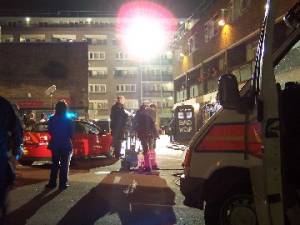 But probably best Kennington's best known theatrical product is Charlie Chaplin who grew up in the area and launched his career at what is now the Coronet Cinema at the Elephant and Castle. Another famous comedian, Max Wall, was born in Glenshaw Mansions on the corner of Brixton Road and Mowll Street. More recently, actor Pierce Brosnan started acting at the Ovalhouse Theatre, whilst the 2005 revival of the BBC's "Doctor Who" (featuring Christopher Eccleston and Billie Piper) was filmed on the Brandon estate, just east of Kennington Park:- The photo on the left shows the Tardis on the estate at night.
But probably best Kennington's best known theatrical product is Charlie Chaplin who grew up in the area and launched his career at what is now the Coronet Cinema at the Elephant and Castle. Another famous comedian, Max Wall, was born in Glenshaw Mansions on the corner of Brixton Road and Mowll Street. More recently, actor Pierce Brosnan started acting at the Ovalhouse Theatre, whilst the 2005 revival of the BBC's "Doctor Who" (featuring Christopher Eccleston and Billie Piper) was filmed on the Brandon estate, just east of Kennington Park:- The photo on the left shows the Tardis on the estate at night.
The area's liberal and theatre traditions live on together in the "Liberal & Radical" club in Kennington Road, which still houses a music hall, and in the White Bear Theatre Club on Kennington Road.
The 1600s also saw Vauxhall becoming the home of a number of industrial premises, including
- boatbuilding, which led 200 years later to the creation of Vauxhall Motors,
- potteries - including the company that became Royal Doulton,
- Buckingham's Vauxhall Glass and other glassworks, and
- Price's Patent Candles,
- not to mention:
- a gasworks (which subsequently moved to Nine Elms and then to near Battersea Park Station, where a gas-holder remained until 2015)
- a brewery,
- a distillery, and
- a soap works.
The Nine Elms area eventually became even more solidly industrialised, and included the gasworks mentioned above (where there was a huge explosion in 1865); cement manufacturing (still there today); a large waterworks (which - because of pollution in the nearby Thames - had to have its water pumped in from West London); the famous Battersea Power Station; and huge railway manufacturing and repair facilities, sidings etc., including the original terminus of the railway that now runs through to Waterloo. There was also a good deal of working class housing in the area, and the voters of Battersea in 1892 elected John Burns to represent them in Parliament, one of the first three Independent Labour Party MPs, an early step along the road to the eclipse of the then powerful Liberal party.
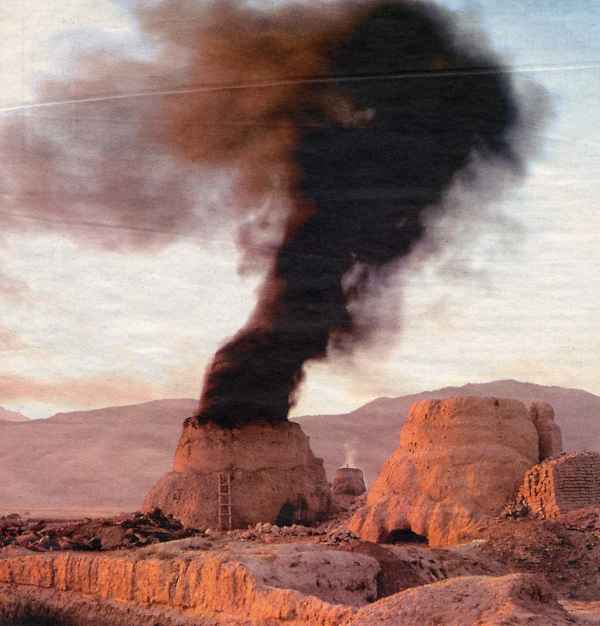 The picture to the left - of a modern day brick kiln in Afghanistan - graphically shows how much smoke was developed by primitive industries such as glass and pottery:- which was one of the reasons why they were banished to Vauxhall, the other side of the river and a good distance from the old City of London. Even as late as 1852, Kennington Common (now Kennington Park) was described as "a small grassless square, surrounded by houses and poisoned by the stench of [acid] works, and by black, open, sluggish ditches".
The picture to the left - of a modern day brick kiln in Afghanistan - graphically shows how much smoke was developed by primitive industries such as glass and pottery:- which was one of the reasons why they were banished to Vauxhall, the other side of the river and a good distance from the old City of London. Even as late as 1852, Kennington Common (now Kennington Park) was described as "a small grassless square, surrounded by houses and poisoned by the stench of [acid] works, and by black, open, sluggish ditches".
And Vauxhall represented only one element of the industrialisation of what is now South-West London. There is an interesting walk (The Wandle Trail) along the River Wandle which features the course of the Surrey Iron Railway (which has a good claim to be the first (horse-drawn) public railway in the World) and which passes the site of William Morris' factory in Colliers Wood. The Wandle river itself was heavily industrialised ("Britain's hardest working river") and used to have over 90 mills along its banks. These days, however, it flows though Morden Hall Park, one of the loveliest parks in London.
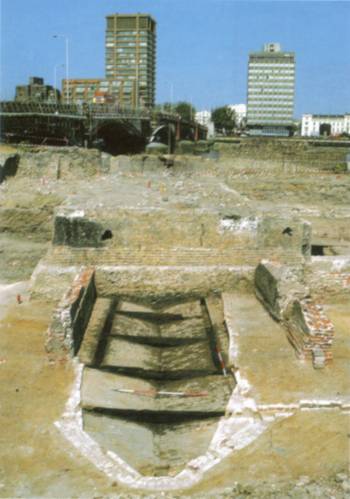 Burrough's Beefeater London Gin distillery next to Tesco on Montford Place is a relatively new addition to the area's industrial heritage. The Burroughs' distillery was originally in Chelsea and moved to Hutton Road, Lambeth (now Beaufoy Walk) in 1908, and then to its present premises in 1958. The building was previously occupied by Haward Bros, pickle manufacturers.
Burrough's Beefeater London Gin distillery next to Tesco on Montford Place is a relatively new addition to the area's industrial heritage. The Burroughs' distillery was originally in Chelsea and moved to Hutton Road, Lambeth (now Beaufoy Walk) in 1908, and then to its present premises in 1958. The building was previously occupied by Haward Bros, pickle manufacturers.
The phrase London Gin refers to the manufacturing method, not the place of manufacture. Indeed, Beefeater is now the only London Gin that is actually made in the city. The company sells 30 million bottles a year but employs only four distillers - and only they know the correct proportions of nearly pure alcohol, water and nine botanicals - including juniper berries of course. Kennington's product is transported by 4 or 5 tankers a week to the Chivas bottling plant in Scotland, where it is diluted to its c.40% retail strength with relatively pure Scottish water. The ultimate owner of the business is now Pernod Ricard.
Another reason for the growth of manufacturing industries in Vauxhall was of course its access to the River Thames, the M2 motorway of its time. But the river was used by many others, including the fishmongers, the mercers and the clothworkers whose livery companies built a bargehouse in Vauxhall, next to John Baker's glasshouse. The picture on the right, with Vauxhall Bridge in the background, was taken during the excavation of the glassworks before the construction of what is now the MI6 building.
The Thames' shoreline in central London is nowadays mainly coarse gravel with occasional old ironwork etc. This is because the shore was originally mud and clay - so gravel (and much else) was commonly tipped on top so as to create a working surface. This is these days being eroded to reveal large stretches of mud and clay, plus occasional peat, showing how vegetation once grew where what is now near the middle of a deep river.
 One souvenir of Vauxhall's nautical past was the old ship's cannon which used to act as a bollard at the corner of Vauxhall Walk and Black Prince Road:- see photo on right.
One souvenir of Vauxhall's nautical past was the old ship's cannon which used to act as a bollard at the corner of Vauxhall Walk and Black Prince Road:- see photo on right.
Then river was of course a barrier as well as a liquid highway. Indeed, there were no bridges across the Thames between London Bridge and Kingston (where the river is no longer tidal) until Fulham/Putney Bridge was completed in 1729. But Kennington began to develop as a major suburb after Westminster Bridge was the next Thames bridge to be completed in 1750. (It was replaced in 1862.)
You can sometimes see lights and/or bales of straw hung beneath bridges. This is because Thames byelaw 29, dating from the 1700's, requires that a bale of straw be hung from any bridge reduced in headroom as a result of repairs. Straw is used so that there will be no damage to any boat or person hitting the bale.
" When the arch or span of a bridge is closed to navigation the person in control of the bridge shall suspend from the centre of that arch or span -
(a) by day, three red discs 0.6 metres in diameter at the points of an equilateral triangle with the apex downwards and the base horizontal;
(b) by night, three red lights in similar positions to the discs displayed by day.
When the headroom of an arch or span of a bridge is reduced from its usual limits but that arch or span is not closed to navigation, the person in control of the bridge shall suspend from the centre of that arch or span by day a bundle of straw large enough to be conspicuous and by night a white light."
Here is a photo of a bale of straw strung beneath Barnes Bridge during the construction of a new footbridge in 2022:
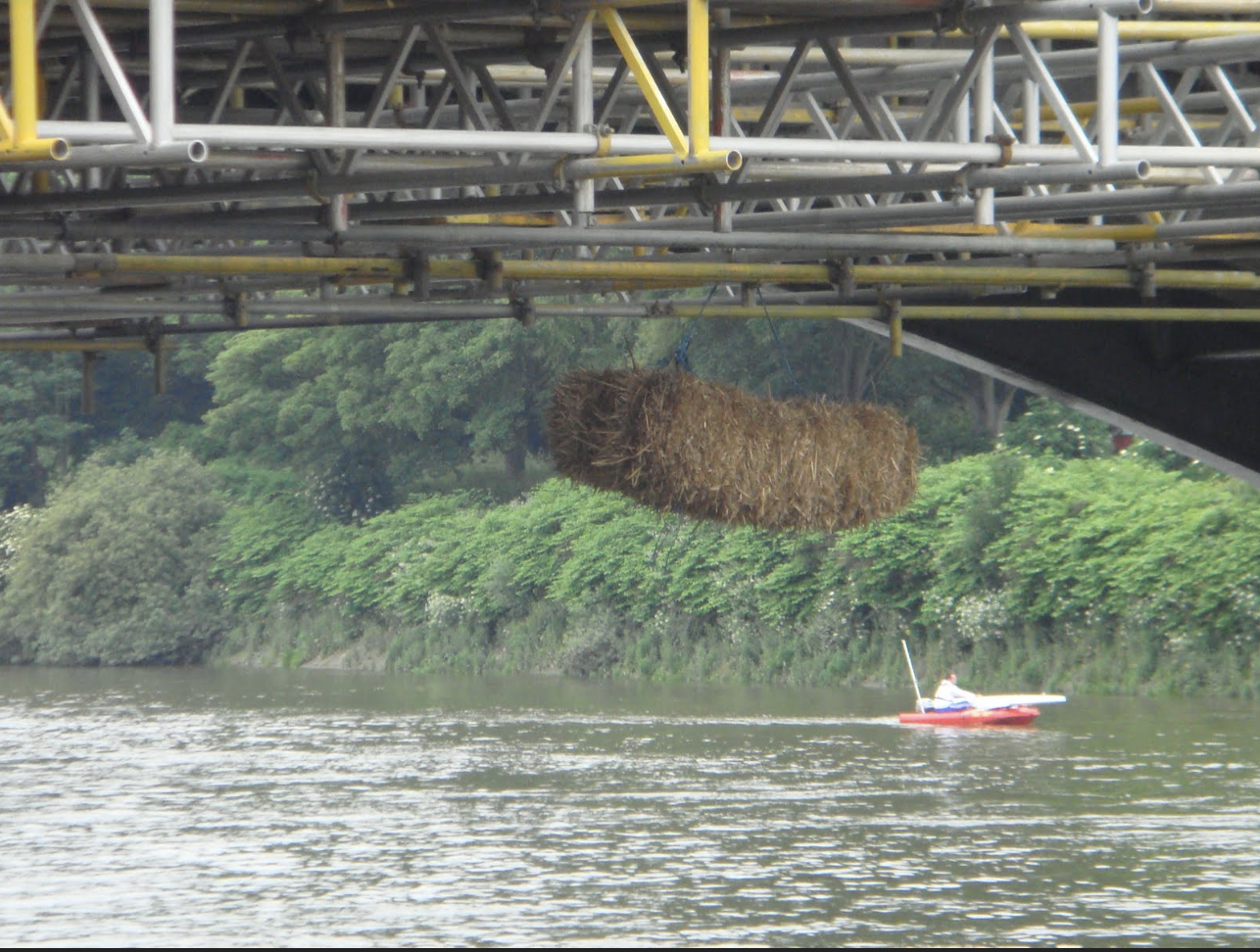
And this was the Millennium Bridge in 2023:
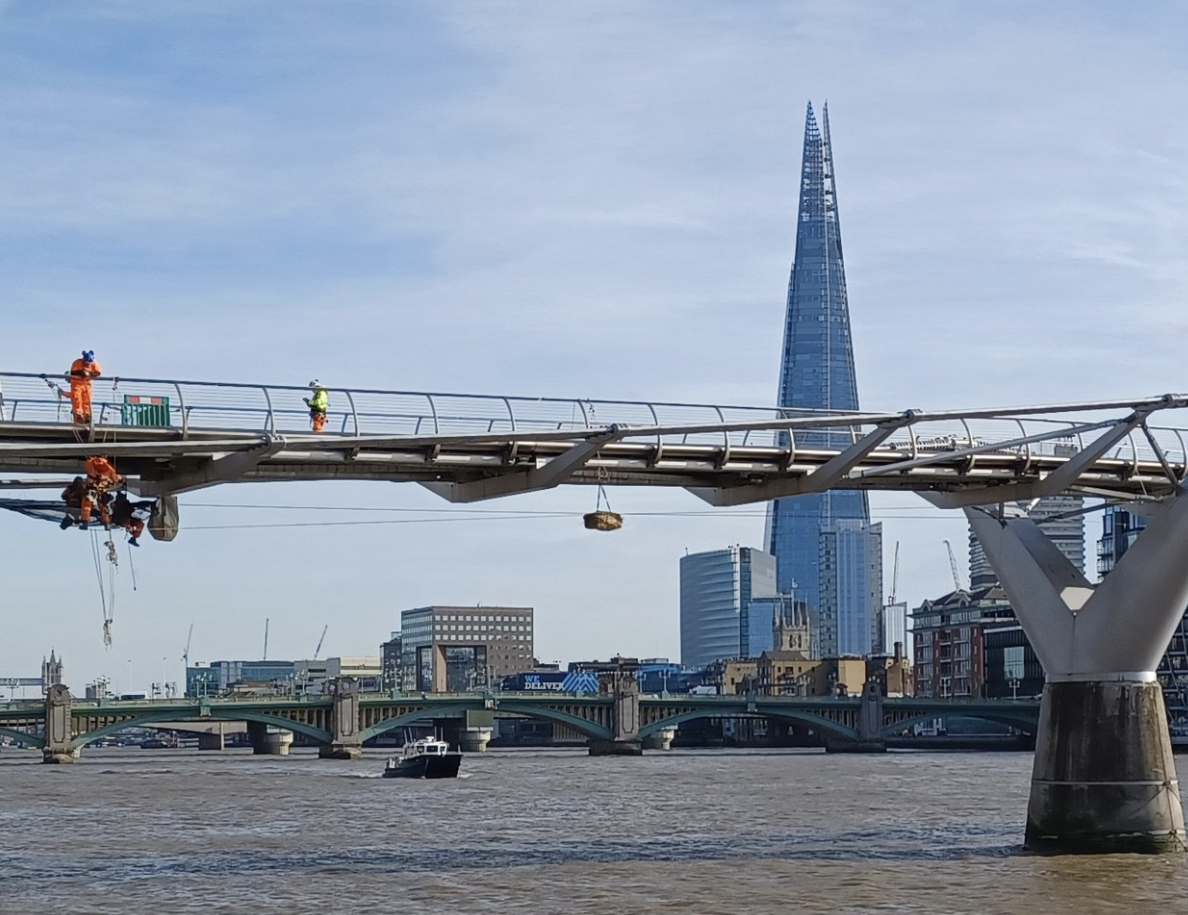
There was then a period during which Lambeth (the area by the river) aspired to become a middle class suburb, and attracted some prominent residents. In the longer term, however, (and unlike north of the river) middle class residential development south/east of the river took place well away from the river - see Lambeth High Street below.
The Thames remained heavily polluted well into the 1800s and caused two major cholera epidemics in Vauxhall in 1848/9 and 1854. But the latter epidemic enabled Dr John Snow (of Broad Street pump fame) to carry out his Grand Experiment which showed that cholera was definitely a water borne disease. Click here to read this fascinating story.
This is a photo of the Windmill Inn on Lambeth High Street in 1860:
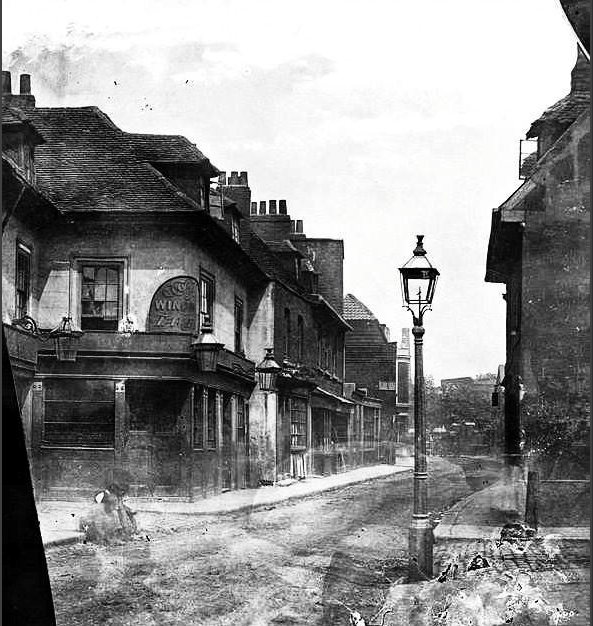
And here is a nice comparison of the area around Lambeth Bridge in 1866 and 2013.
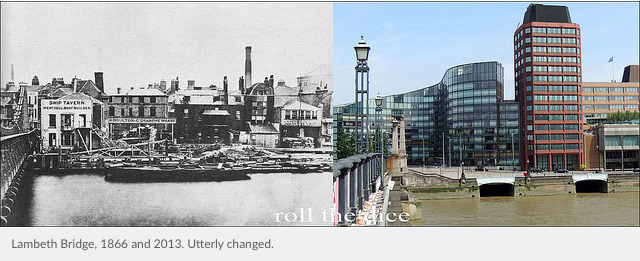
Click here to read page 3 of this story.
Martin Stanley§